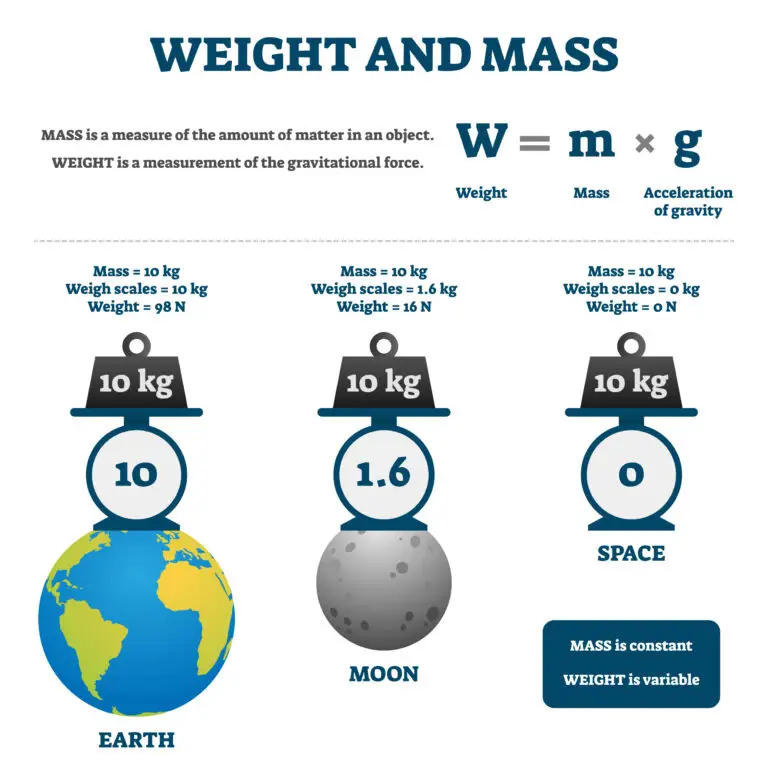Mass

Table of Contents
What is Mass?
Mass is a property in physics that quantifies the amount of matter in an object. As a scalar quantity, it only has magnitude and no direction, distinguishing it from vector quantities like force or velocity. Mass is crucial because it directly correlates with the amount of inertia an object possesses: the more mass an object has, the more it resists changes in its state of motion, making it harder to accelerate or decelerate.
The standard unit of mass in the International System of Units (SI) is the kilogram (kg). A balance scale is often used when measuring mass, especially in a laboratory or industrial setting. This device compares the mass of an object to known masses, allowing for a precise measurement.
In everyday terms, mass is sometimes confused with weight, but they are distinct: mass measures how much matter an object contains, while weight is the force exerted by gravity on that mass.
Properties of Mass
Inertia
Inertia is connected to mass, as it is the property that quantifies an object’s resistance to changes in its motion or rest. The more mass an object has, the greater its inertia. This means that heavier objects are more resistant to changes in their speed or direction of movement.
Essentially, inertia is a measure of how difficult it is to change an object’s current state, whether it is moving or stationary.
Gravitational Interaction
Newton’s law of universal gravitation illustrates how the gravitational force between two objects depends on their masses and distance. Specifically, the force of gravity increases with the mass of the objects and decreases with the square of the distance between them. This means that more massive objects exert a stronger gravitational pull.
For example, the very massive Earth has a strong gravitational pull, which is why we feel firmly anchored to its surface. On the other hand, smaller objects like a basketball have a much weaker gravitational force. The law implies that if either of the object’s masses were to increase, the gravitational force between them would also increase. Conversely, as the distance between the objects grows, the gravitational force diminishes rapidly.
Measuring Mass
Measuring mass can be done through various methods and instruments, each suited to different contexts and levels of precision. Balance scales, one of the oldest and most traditional methods, compare the mass of an unknown object to that of known standard weights. When the scale balances, the unknown mass is equal to the known mass used on the other side of the balance.
Electronic scales, on the other hand, use modern technology to measure mass directly. These scales typically rely on load cells, which convert the force of the mass into an electrical signal that is then interpreted to give a mass reading. Electronic scales can provide quick and accurate measurements and are commonly used in homes, offices, and various industries.
In more specialized scientific settings, mass spectrometers are employed to measure the mass of atoms, molecules, and ions with high precision. These instruments work by ionizing samples and then separating the ions based on their mass-to-charge ratio using electric and magnetic fields.
Importance of Mass
In Newtonian mechanics, mass is crucial for determining the motion of objects under the influence of forces; it directly affects how much an object will accelerate under a given force, following Newton’s second law of motion (F=ma). Gravitational physics also relies heavily on mass because the gravitational force between two objects is proportional to the product of their masses, as detailed in Newton’s law of universal gravitation.
In thermodynamics, mass plays a role in calculating the amount of heat needed to change the temperature of a substance, given its specific heat capacity. The relationship between mass and energy is most famously encapsulated in Einstein’s mass-energy equivalence formula, E=mc^2, which shows that mass can be converted into energy and vice versa, highlighting the profound impact of mass on the energy content of a system.
Relationship Between Mass and Weight
In Newtonian mechanics, mass is crucial for determining the motion of objects under the influence of forces; it directly affects how much an object will accelerate under a given force, following Newton’s second law of motion (F=ma). Gravitational physics also relies heavily on mass because the gravitational force between two objects is proportional to the product of their masses, as detailed in Newton’s law of universal gravitation.
In thermodynamics, mass plays a role in calculating the amount of heat needed to change the temperature of a substance, given its specific heat capacity. The relationship between mass and energy is most famously encapsulated in Einstein’s mass-energy equivalence formula, E=mc^2, which shows that mass can be converted into energy and vice versa, highlighting the profound impact of mass on the energy content of a system.
Related Links
Density
Faraday’s Law
Pressure
Turgor Pressure